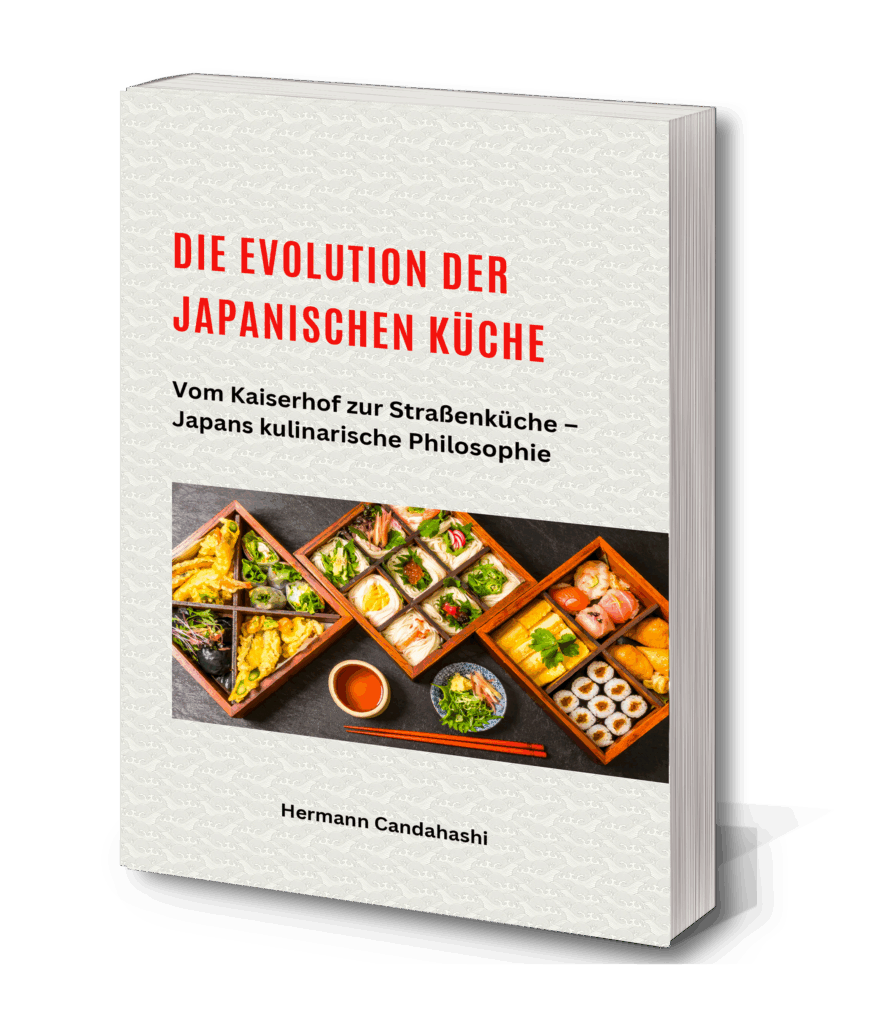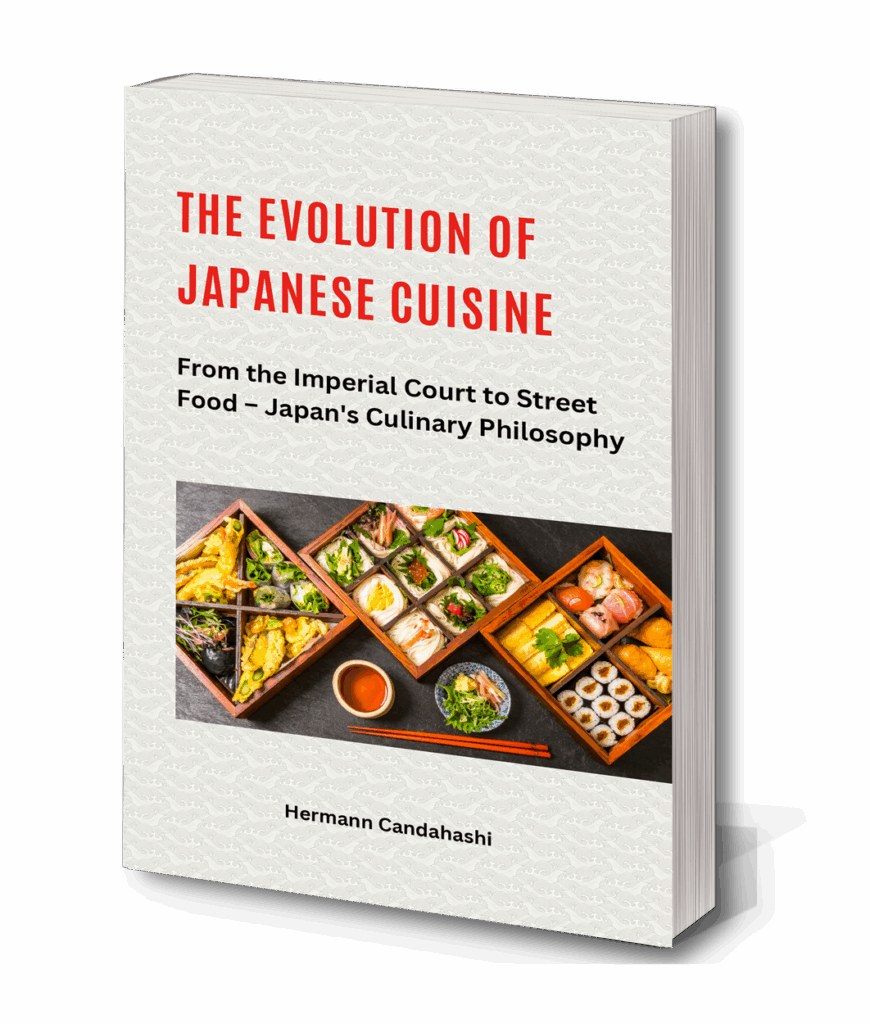

Discover the fascinating philosophy of Japanese cuisine – in all its depth, history, and diversity! Immerse yourself in the unique culinary journey “The Evolution of Japanese Cuisine” a comprehensive reference work on the development of Japanese culinary culture from early imperial banquets to modern street food on the bustling streets of Tokyo and Osaka.
This exceptional book by renowned author Hermann Candahashi combines popular scientific analysis, cultural depth, and gripping storytelling in a fascinating blend that will delight history buffs, culinary enthusiasts, Japan fans, and specialist readers alike. From the influences of Zen Buddhism to the disciplined culinary culture of the samurai to the Western influences of the Meiji period – here you will learn how taste, philosophy, and aesthetics have evolved in Japan over the centuries.
What makes this book special:
- A unique look at the historical roots of Japanese cuisine
- In-depth information on regional specialties from Hokkaido to Okinawa
- Exciting insights into the significance of shojin ryori, kaiseki, and sushi
- Presented in an understandable way for laypeople, yet in-depth for experts
- Ideal for gourmets, Japanologists, travelers, food bloggers, and professional chefs
Learn why Japanese cuisine is among the most renowned in the world today – and how deep-rooted traditions, religious influences, regional peculiarities, and historical upheavals continue to shape it today.
With the help of this multifaceted work, enter a world full of enjoyment, knowledge, and cultural depth – for your library, your kitchen, or your next adventure in Japan!
An excerpt:
Japanese cuisine has a quiet power. It doesn’t shout, it doesn’t posturing loudly; it comes with restraint, with precision, with respect. And the more I delved into it, the more I realized: it’s not just a form of food consumption; it’s philosophy, history, spirituality, and aesthetics all rolled into one. Every meal tells a story. Every taste has a past.
This book arose from a deep fascination with how food can be an expression of culture, identity, and the spirit of the times. Japanese cuisine is a particularly impressive example of this. It has evolved over centuries, experienced upheavals, wars, isolation, and globalization-and has always retained its soul. Or rather, it has continually reinvented itself while preserving its essence.
The journey begins in the Jomon period, an era when people still lived in close symbiosis with nature. They gathered chestnuts, fished in the sea, and cooked in crudely shaped clay pots over an open fire. What initially seems archaic already contains the seeds of the attitude that would later form the backbone of Japanese cuisine: respect for what nature provides and a strong sense of seasonality.
Later, in the Yayoi period, rice becomes a cultural constant. A grain becomes currency, a sacrifice, a symbol of life itself. Buddhism then brings not only a religious worldview, but also new eating habits. The idea of purity, abstinence, and mindfulness also manifests itself on the plate. Vegetarian cooking traditions emerge that remain deeply rooted in the consciousness of many Japanese to this day.
And then: the courtly Heian period, in which cuisine is elevated to an art form. Meals are no longer merely functional, but a reflection of social order, a vehicle of symbolism, an instrument of representation. One doesn’t just eat, one celebrates. And yet the focus always remains on the essential – it’s never about excess, but about balance.
A leap forward to the Edo period shows how the urban population suddenly created its own culinary cosmos. Street food was born. Sushi became portable, tempura a quick treat, ramen a comfort food for the masses. And yet: the precision with which even the simplest dishes were prepared, the artistry, and the artisanal ethos remained intact. Street cuisine is no less venerable than that of the palaces.
Western influences also left their mark. Contact with Portugal in the 16th century brought not only tempura batter, but also sugar and new techniques. During the Meiji period, Japan continued to open up, absorbing Western ideas and integrating them-without abandoning its identity. This gave rise to dishes like tonkatsu and omurice, hybrid forms that could hardly be more Japanese. They demonstrate that this cuisine is not a static relic, but a living system, open to change.
What fascinates me time and again is Japanese cuisine’s ability to unite opposites: austerity and playfulness, depth and simplicity, tradition and innovation. A kaiseki menu, composed like a poem, embodies this philosophy as much as a steaming bowl of ramen on a rainy evening in Osaka.
The global spread of Japanese cuisine in recent decades is a story in itself. Sushi bars all over the world, matcha lattes in coffee shops, bento boxes on supermarket shelves. But with popularity came simplification. Much has been stripped down, standardized, and adapted to the Western palate. That’s why it’s all the more important to look beneath the surface, rediscover the original spirit, and tell the stories behind the dishes.
This book isn’t a pure cultural history, a recipe book, or a travel documentary-and yet it contains a little bit of everything. It’s an attempt not just to describe Japanese cuisine, but to understand it. And it’s an attempt to invite the reader to discover with me what makes this cuisine so unique. I spoke with chefs, housewives, monks, mothers, and grandfathers. I ate in small izakayas and kaiseki restaurants. I browsed markets and peered into the pots in temple kitchens. I tried to taste what time is, what silence is, what change is.
In doing so, I realized: Eating in Japan means becoming part of a heritage. It means performing a ritual that is greater than oneself. It means connecting-with nature, with history, with the present.
I hope that this book not only informs, but also touches. That it opens a window into a world where food is more than function. A world where a piece of pickled radish tells just as much of a story as an artfully arranged sashimi.
A world where the invisible becomes palatable. When you read this book, take your time. Let the images emerge. Taste with your mind, understand with your palate. And maybe, just maybe, you’ll see the next piece of sushi with different eyes afterward.
Because it’s this different way of seeing, this different way of perceiving, that makes Japanese cuisine so special. At first, it seems quiet, almost inconspicuous. But beneath this surface lies a deep web of symbolism, technique, ritual, and history. You don’t have to speak Japanese to understand the meaning of a bowl of steaming miso soup on a cold winter morning. You don’t have to have dined at the imperial court to sense that a kaiseki menu is more than just a sequence of courses. You just have to be willing to listen, taste, and look-with an open mind and genuine curiosity.
A central theme of this book is therefore the concept of mindfulness. Mindfulness not only in the sense of spiritual practice, but as a cultural constant that resonates in all aspects of Japanese cuisine. Whether in the selection of ingredients, the combination of flavors, the presentation, or the consumption – this deep, almost meditative relationship to what food is is evident everywhere. Food is not a consumer good, but an encounter. An encounter with nature, with the cycle of the year, with the hands that prepare it, with oneself.
Perhaps this is precisely what fascinates us in the West about Japanese cuisine. In a world where we have often lost touch with our diet, where meals are consumed in passing, in front of screens, on the go, while standing, it offers an alternative. A return to consciousness. Not as a dogma, but as an invitation.
Of course, Japanese cuisine has also changed. Globalization, urbanization, technological developments – all of this has left its mark. And yet, the core remains intact to this day: the principle of harmony, seasonality, the balance between flavor, color, texture, and temperature. These principles run like a thread through centuries of culinary history.
A particularly striking example of this is the concept of Ichiju-Sansai – “one soup, three side dishes.” It is more than a formula for a balanced meal. It is an expression of a way of life. Nothing is superfluous, nothing is missing. The components complement each other, they respect each other, they subordinate themselves to the whole. It is this attitude that is also reflected in larger culinary concepts such as Kaiseki or Shojin Ryori.
And it is this attitude that is reflected in the small details of everyday life. In the way an onigiri is shaped. In the care with which bento boxes are filled. In the tranquility of a tea ritual. Or in the silent gesture with which one says before eating: “Itadakimasu” – “I humbly accept.” A gesture of gratitude for everything that made this meal possible.
